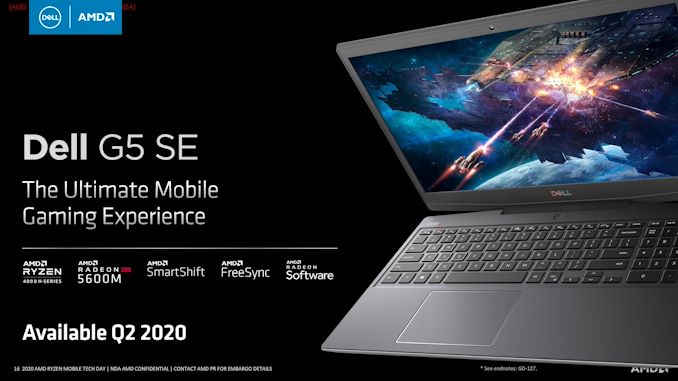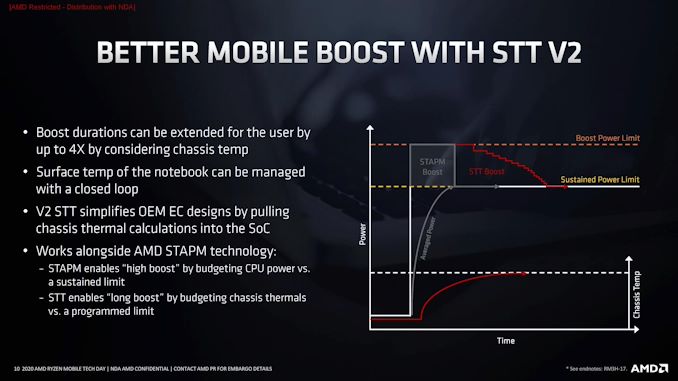AMD Details Renoir: The Ryzen Mobile 4000 Series 7nm APU Uncovered
by Dr. Ian Cutress on March 16, 2020 11:00 AM ESTAMD SmartShift
We’ve covered AMD’s SmartShift before, when it was announced at CES, as a technology that allows a system management controller to interact with both the mobile APU and an AMD graphics card in the same system in order to shift power where it is needed. This solution is still based on separate power rails between the two, however the use of the scalable control fabric (SCF) part of Infinity Fabric means that parts of the APU and parts of the GPU can interact together in this way. Ultimately AMD believes they can score 10-12% better on heavy CPU workloads like CineBench or gaming workloads like The Division.
The solution is firmware based, but requires interaction between qualified hardware. AMD states that often in these sorts of CPU+GPU designs, while the chassis has a total design TDP, if one of the elements of the system is idle, then the other can’t take advantage of the extra turbo headroom available. SmartShift aims to fix that.
What’s new here is that AMD is primarily focus will be on Ryzen Mobile 4000 + Vega 10 style systems. The first one with SmartShift enabled will be the Dell G5 SE. The Dell G5 SE is being labelled as ‘the ultimate mobile gaming experience’, and will feature a new H-series processor, the Radeon RX 5600M, SmartShift, FreeSync, and have a 15-inch display. The unit will be coming out in Q2.
System Temperature Tracking (Version 2)
SmartShift is also part of a new System Temperature Tracking paradigm that AMD is implementing in its new APUs. Even if there is power headroom, a system can’t turbo if there isn’t thermal headroom. Smart Temperature Tracing v2 (or STTv2) is designed to help a system boost for longer by knowing more about the thermal profile of the device.
My placing additional thermal probes inside the system, such as on hot controllers or discrete GPUs, the readings of these can be passed through the Infinity Fabric to an embedded management controller. Through learning how the system thermals interact when different elements are loaded, the controller can determine if the system still has headroom to stay in turbo for longer than the current methodology (AMD’s Skin Temperature Aware Power Management). This means that rather than having a small number of sensors getting a single number for the temerpature of the system, AMD takes in many more values to evaluate a thermal profile of what areas of the system are affected at what point.
What STTv2 does at the end of the day is potentially extend the boost time for a given system, depending on its thermal capabilities. For example, the Lenovo Yoga Slim 7 which we are expecting for review only has a 15 W processor inside, but the chassis has been built for a 25 W TDP design, which means that STTv2 should kick in and provide the user with peak performance for longer.














95 Comments
View All Comments
Cooe - Friday, April 23, 2021 - link
Delusional idiot alert. Because creating super expensive HEDT pin-out sized bespoke sockets solely for low-mid end market desktop APU's definitely makes ANY kind of sense... -_-lisabmassey - Wednesday, March 25, 2020 - link
Make 6150 bucks every month... Start doing online computer-based work through our website. I have been working from home for 4 years now and I love it. I don't have a boss standing over my shoulder and I make my own hours. The tips below are very informative and anyone currently working from home or planning to in the future could use this website... WWW.iⅭash68.ⅭOⅯsuperflex - Thursday, May 21, 2020 - link
Do you have to swallow for $6150RamIt - Monday, March 16, 2020 - link
Looking forward for a test unit. Battery life and mild gaming may make me shift to AMD.EliteRetard - Monday, March 16, 2020 - link
I think a 48-4900 HS without a GPU would be the perfect laptop for most people.I've been wishing for something like this for a very long time.
High core count and TDP for real work, with enough IGP for casual gaming. Still lower power than a 45w chip, especially since they're always paired with at least a 25w GPU (even though most don't need it).
U series for those who care about battery above all else, HS + IGP for the vast majority, and H + DGPU for gamers and mobile workstations.
Please make it so!
deksman2 - Monday, March 16, 2020 - link
Actually, I'd prefer they give the APU full 45W TDP 'breathing room', otherwise it will 'choke' on the 35W TDP constraints.Most laptop OEM's don't really pay too much attention in designing adequate cooling systems for their designs, which can lead to thermal throttling, overheating and performance losses.
I'd rather they work with the 'maximum allowed TDP' for the chip (say 45W) design a cooling system that's more than enough to handle it and work from there.
I'd prefer seeing 4900H with a decent dGPU such as RX 5700M and proper cooling design to produce limited noise under full load and that both CPU/IGP and dGPU can reach/sustain their maximum advertised performance indefinitely (or for as long as one needs them).
I need productivity on the go, and I have no time for cooling shenanigans from OEM's.
EliteRetard - Monday, March 16, 2020 - link
35w gives tons of "breathing room", it's over twice the TDP of U series parts.It's also half the power of a 45w CPU plus low end 25w DGPU.
I fully expect it'll maintain a good 3+GHz under full load (vs 2GHz for U series).
For cooling, OEMs can just slap on the cooler from their 45w designs.
The vast majority of people don't need a DGPU, but they are currently forced to buy one if they want any performance CPU. That costs them more money, increases weight, and reduces battery life (two fold, less space for battery and higher draw).
You obviously want a gaming laptop, and that's not at all what I'm discussing.
80% of the market would be incredibly well served with a 35w HS APU.
Far better than the crappy U series they've been forced into.
For the 10% who want battery life over anything, they can get a 15w U series.
For the 10% who want max gaming they can get a 45w H series.
I've been begging for a logical laptop for so long... I seriously can't understand why OEMs have refused to even consider it. In what other industry do manufactures refuse to service the needs of 80% to cater only for the odd 20%? "Oh you want something practical? HA screw you!"
Imagine if you could only buy a 2 seat scooter for $15+k, or a massive 4 door 8ft bed truck for $100+k. And there are literally no other options, new or used...there has been only these two choices being sold by every car maker in the entire world. If you want to do anything more than a scooter can handle, you are literally forced to buy a massive overkill option no matter how impractical.
That's literally how the laptop market has been for almost a decade.
wolfesteinabhi - Tuesday, March 17, 2020 - link
i totally see where you are going with this ...but for vast majority .. people dont care about CPU's and performance ... all they ask is a cheap laptop with good battery life....they dont even compare or ask for model numbers for CPUs .... they jsut see its as core i3 or core i5 ... or Ryzen 3/5 .. thats all they "perceive" as performance..... and lastly they want it dirt cheap. (also they expect to have a dGPU to always out perform iGPU ....even if dGPU is pants like MX150)erple2 - Wednesday, March 18, 2020 - link
Frankly, the 4800 is much more capable than what most people need in a laptop. I've seen people effectively develop applications on an Atom based Chromebook with great success, and based on what I see other people that aren't enthusiasts doing, even the bottom tier 4600H is more than they need. It's exceedingly rare for any normal user to need more than even 4 cores to do their normal workload of opening tabs, checking email, talking on videochat.Namisecond - Thursday, March 26, 2020 - link
I agree, for general computing tasks, 4 cores or 4 fully powered threads is good enough for most people. In a laptop, for a lot of people, the important factors are: size/weight, screen quality, battery life, design aesthetics, not necessarily in that order.I used to buy thin-and-light gaming laptops for my own perceived needs...but recently, I've found that I'm carrying the atom-powered thin and light, because the screen is good enough, the size and weight is good, and it has all-day battery life.